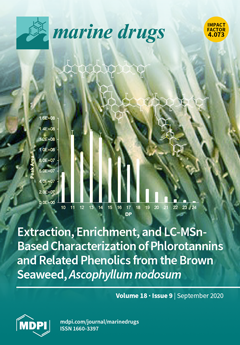The use of natural products in skin care formulations gained interest as a concern for modern societies. The undesirable side effects of synthetic compounds, as well as the associated environmental hazards, have driven investigation on photosynthetic organisms as sustainable sources of effective and environmentally friendly ingredients. The use of natural extracts in cosmetics has been highlighted and, along with plants and algae, cyanobacteria have come into focus. Due to their low culture demands, high grow rates and ability to produce a wide variability of bioactive metabolites, cyanobacteria emerged as an economic and sustainable base for the cosmetic industry. In this study, we evaluated the potential of ethanol extracts of picocyanobacteria strains of the genera
Cyanobium and
Synechocystis and filamentous strains of the genera
Nodosilinea,
Phormidium and
Tychonema for skin applications, with focus in the field of anti-aging. The extracts were analyzed for their pigment profile, phenolic content, antioxidant potential, cytotoxicity against keratinocytes (HaCat), fibroblasts (3T3L1), endothelial cells (hCMEC/D3) and capacity to inhibit hyaluronidase (HAase). The total carotenoid content ranged from 118.69 to 383.89 μg g
−1 of dry biomass, and the total phenolic content from 1.07 to 2.45 mg GAE g
−1. Identified carotenoids consisted of zeaxanthin, lutein, canthaxanthin, echinenone and β-carotene, with zeaxanthin and lutein being the most representative (49.82 and 79.08 μg g
−1, respectively). The highest antioxidant potential was found for
Phormidium sp. LEGE 05292 and
Tychonema sp. LEGE 07196 for superoxide anion radical (O
2•−) scavenging (IC
50 of 822.70 and 924 μg mL
−1, respectively). Low or no cytotoxicity were registered. Regarding HAase inhibition,
Tychonema sp. LEGE 07196 and
Cyanobium sp. LEGE 07175 showed the best IC
50 (182.74 and 208.36 μg mL
−1, respectively). In addition, an increase in fibroblast proliferation was registered with these same strains. From this work, the ethanol extracts of the species
Tychonema sp. and
Cyanobium sp. are particularly interesting for their potential application in anti-aging formulations, once they stimulated fibroblast proliferation and inhibit hyaluronic acid digestion.
Full article






